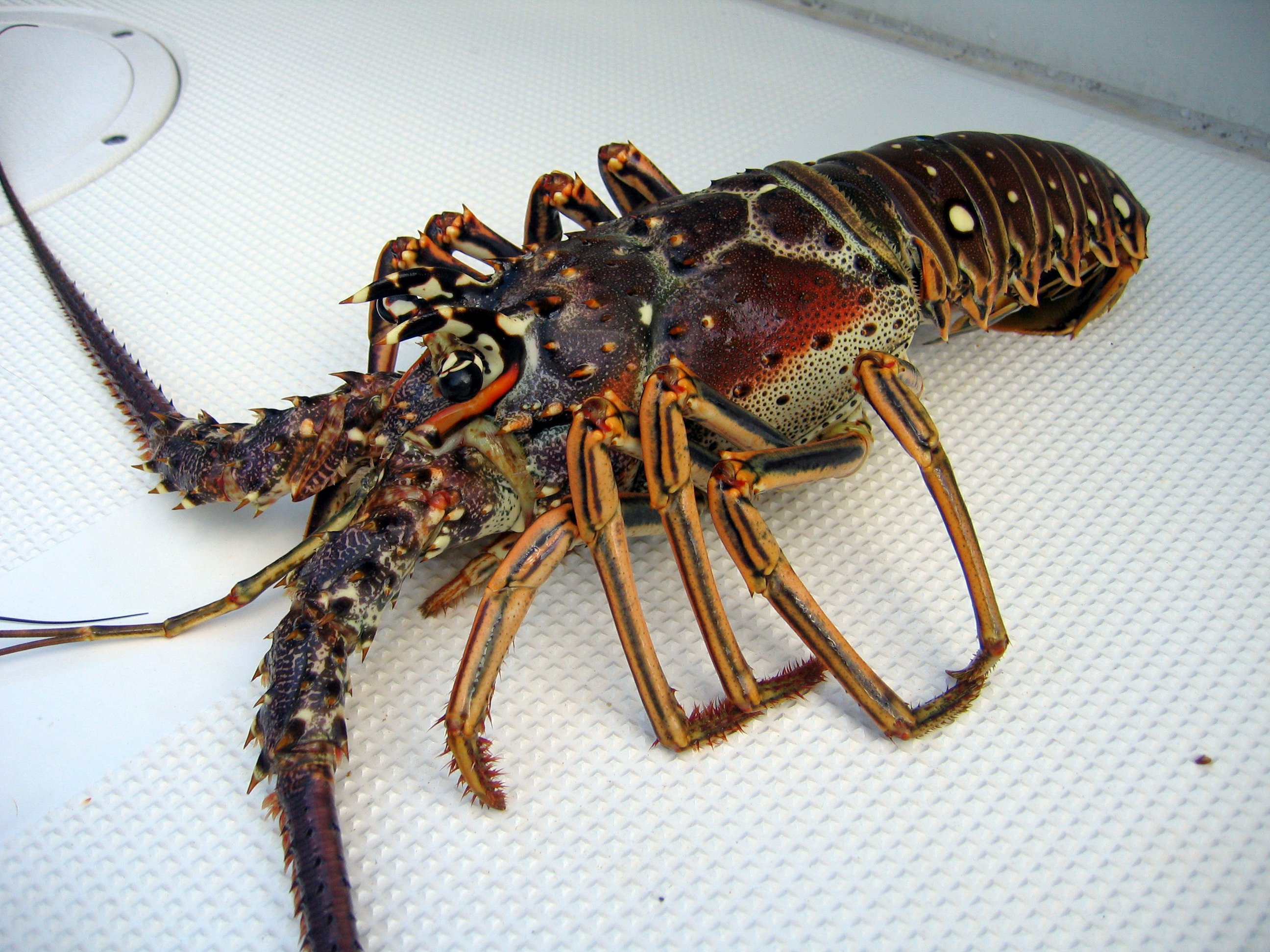- Panulirus argus
Taxobox | name = "Panulirus argus"

image_width = 240px
regnum =Animal ia
phylum =Arthropod a
subphylum = Crustacea
classis =Malacostraca
ordo =Decapoda
familia =Palinuridae
genus = "Panulirus "
species = "P. argus"
binomial = "Panulirus argus"
binomial_authority = (Latreille, 1804)"Panulirus argus" is a species of
spiny lobster that lives on reefs and inmangrove swamps in the westernAtlantic Ocean . It is known as the "Caribbean spiny lobster", "Florida spiny lobster" or "West Indies spiny lobster" and is also referred to as "lagostino", "crawfish", "crayfish" or "bug." They have long, cylindrical bodies covered with spines. Two large spines form forward-pointing "horns" right above each eyestalk. They are generally olive greenish or brown, but can be tan to mahogany. There is a scattering of yellowish to cream-colored spots on thecarapace and larger (usually four to six) yellow to cream-colored spots on theabdomen . They have noclaw s (pincers). The first pair of antennae are slender, black or dark brown andbriamous . The second pair of antennae are longer than the body, and covered with forward pointing spines. The bases of the second antennae are thick, can have a bluish tinge, and are likewise covered with rows of spines. They are adept at using the larger antennae like rapiers for defenseFact|date=June 2007. The legs are usually striped longitudinally with blue and yellow and terminate in a single spine-like point. Thesomite s of the abdomen are smooth and have a shallow furrow across the middle. Each has pairs ofswimmeret s on the underside that are yellow and black. The lobes of the tail are colored similarly to the swimmerets.They are found at depths of up to 90 m from
Brazil toNorth Carolina ,including the entireGulf of Mexico andCaribbean Sea , theBahamas ,Bermuda , easternSouth America with occasional reports fromWest Africa . Although they range throughout the entire Gulf of Mexico, in the northern portions of the Gulf they generally are only found at depths of 33 m and greater due to theseasonal variation in the water temperature. Around the southern portion of theFlorida peninsula and throughout the Bahamas and Caribbean, they are found in shallower water. They generally prefer habitat with some sort of cover and can be found aroundcoral reef s,artificial reef s,sponge s, bridge pilings, wooden bridge bumpers, piers, and under the prop roots ofmangrove s. They are nocturnal, taking to cover during the day. They serve as prey foroctopus es,nurse shark s, andstingray s, although their greatest predator is man. Although they generally prefer to remain near cover, at times groups of hundreds will line up and march across the floor of some of the waters of southern Florida'sBiscayne Bay ,Card Sound , andFlorida Bay . The purpose of these "migrations" is not known, but they generally occur in the fall and may be in response to falling temperatures in the shallows."P. argus" may reach up to 60 cm (24 in) long, but typically around 20 cm (8 in), and is fished throughout its range [cite book |url=http://ip30.eti.uva.nl/bis/lobsters.php?selected=beschrijving&menuentry=soorten&id=149 |title=FAO species catalogue Vol. 13: Marine lobsters of the world. |author=
Lipke Holthuis |date=1991 |publisher=FAO] . It is the number one food export of the Bahamas, and rivals the shrimp industry in theFlorida Keys incommercial value . They are eagerly sought by both commercial lobstermen and sport divers in South Florida, the Caribbean, and the Bahamas. In Florida, there is a season where the spiny lobster may be taken, usually from the beginning of August to the end of January. A special "sport diver season" a few days before the start of the regular lobster season gives recreational divers a "head start" in catching them. Divers catch them by gloved hand, often "tickling" them out of their dens with adowl or small stick. In the Bahamas and Caribbean, they are often also speared or gigged (Florida game regulations prohibit taking them by these methods). Commercially, they are caught with lobster traps similar to those used by lobster fishermen inNew England . The traps are usually baited with dead fish or chicken necks.Like most decapods, the Florida spiny lobster hatches from eggs carried externally by the female. They begin life as a free-swimming, microscopic larvae. After undergoing several molts, they settle to the sea floor and live in holes or crevices in the reef or between mangrove roots. As they grow, they molt or shed their
exoskeleton to make room for their larger bodies. As in other decapods, after molting, the new exoskleton or shell is soft, and has to harden. During this time, the lobster is highly vulnerable to predation and as a result they are usually very retiring until the new exoskleton hardens fully. They consumedetritus , vegetable material, and dead animals and fish they find on the bottom.References
Wikimedia Foundation. 2010.
